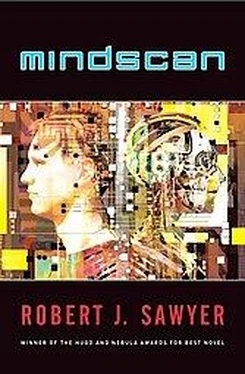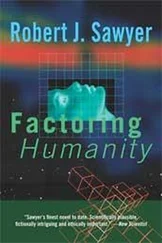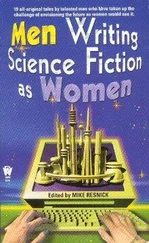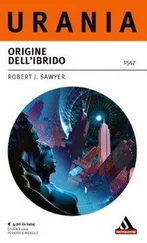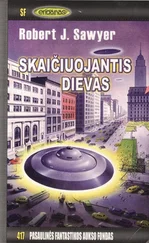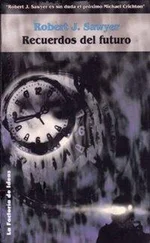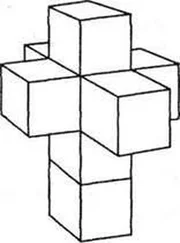“But—forgive me, doctor, I don’t mean to be dense—but if you don’t know what causes consciousness, how can you reproduce it? How do you know what to reproduce?”
Porter nodded. “Consider it like this: I don’t know anything about music. When I was in school, they thought I’d be a menace to every hearing person if they gave me a musical instrument to play, so I was assigned to the vocal class, along with all the other tone-deaf people. So, I know nothing at all about what makes Beethoven’s Fifth a great piece of music. But as an engineer, if you brought me a CD recording of it, and asked me to copy it onto a MemWafer, no problem—I could do that. I don’t look for the ‘musical’ stuff on the CD; I don’t look for the ‘genius’ on the CD. I just copy everything to the new medium. And that’s exactly what we do when we’re transferring consciousness.”
“But, if you don’t know what you’re looking for, isn’t it possible you’ve missed something key?”
“No. Most psychologists would say that even if all we did was transfer a map of the interconnections between neurons, and the various levels of neurotransmitters, we’d have captured everything meaningful in the brain. And we certainly do that.”
“It sounds like an enormous amount of data is involved,” said Deshawn.
“It’s not as much as you might think,” replied Porter. “We’ve found fractal resonances in a lot of it—that means that the same patterns are repeated over and over again at different levels of resolution. The data would compress very nicely if one were inclined to keep a record of it.” I sat up in my chair as he said this, but, since I was behind Karen, there was no way for me to catch her eye.
“And so by copying this information, you’ve copied consciousness as well?” asked Deshawn. “Simply by copying the neural networks and neurotransmitter levels?”
“Well, some argue that those things aren’t the true physiological correlates of consciousness—that is, that they aren’t in and of themselves the physical indications of conscious thought—and they point to paramecia as proof.”
“Paramecia?” repeated Deshawn.
“Yes. Um, your honor, if I may…?”
Herrington nodded, and Porter got up out of the witness stand, looking relieved to no longer be squashed. He pulled a small remote control from his jacket’s other pocket, and images started appearing on the wall screen.
“A paramecium,” said Porter, “is a kind of protozoan—a one-cell lifeform. Paramecia don’t have a nervous system, since nervous systems are made up of specialized nerve cells, and obviously a one-celled lifeform can’t have any specialized cells. And yet, without neurons or neurotransmitters, a paramecium can learn. Not much, I grant you—but it can learn. You can teach it that if it comes to a divided pathway, going left will always result in a mild shock and going right will always result in getting food.” The images on the wall illustrated this. “Somehow, the paramecium learns this despite having no nervous system at all. And that at least suggests the possibility that neural nets are not actually what’s responsible for our awareness.”
“Well, then,” said Deshawn, “how does awareness come about?”
Different visuals appeared on the screen.
“One argument,” said Porter, “is that the microtubules that make up the cytoskeleton of a cell are where the awareness, the infinitesimal consciousness, of a paramecium—or a human—resides. Microtubules are like hollowed-out cobs of Indian corn: they have an empty center, but are covered with kernels. And, just like in Indian corn, the kernels can form patterns. Some argue that those patterns move and replicate like cellular automata, and—”
“Cellular automata?” said Deshawn.
More visuals, like animated crossword-puzzle boards.
“Yes, indeed,” said Porter. “Consider the microtubule’s surface to be a grid of squares rolled into a tube. Imagine some of the squares are black, and some are white—that’s the Indian corn appearance I was referring to a moment ago. Imagine, too, that the squares respond to simple rules, such as this: if you’re a black square, and at least three of the eight other squares surrounding you are also black, then you should turn white.” The visual display illustrated this.
“See?” said Porter. “A very simple rule. But from out of such rules, complex patterns appear on the grid. For instance, you can get boomerang shapes made up of a consistent pattern of squares that actually move across the grid—every time the basic rule is applied, the whole cluster might move one space to the left. You also get shapes that devour other shapes, and big shapes that split into two smaller, but otherwise identical shapes.” We all watched as these things happened on the screen.
“Now, consider that,” said Porter. “The patterns are responding to stimulus in the form of the rule that is being applied. Well, response to stimulus is one of the standard criteria for life. The patterns are moving, and, again, movement is also one of the standard criteria of life. The patterns are devouring other patterns, and, again, eating is a third standard criterion of life. And the patterns are reproducing, and, of course, doing that is also one of the standard criteria of being alive. Indeed, cellular automata are one form of what’s long been called artificial life, although I’d argue that the word ‘artificial’ is unnecessary. They are life.”
“And so your Mindscan process copies the patterns of cellular automata?” said Deshawn.
“Indirectly, yes.”
“Indirectly? If there’s a chance that you’ve missed something—”
“No, no. We get the information copied with absolute fidelity, but it’s physically impossible to actually scan the configuration of cellular automata.”
“Why?”
“Well, as I said, we record the configuration of the neural networks—the positions and interconnections of every neuron in your brain—but we don’t record the pattern of cellular automata on the surface of the microtubules within those neurons. See, tubulins—the little kernels that make up the microtubule cob—can flip between two states, which I’ve been showing as black and white in the graphics, here, so that they make the complex animated patterns you’ve seen the surface of the microtubule. But the two states aren’t really black and white. Rather, they’re defined by where an electron happens to be—in the tubulin’s alpha subunit pocket, or in its beta subunit pocket.” He smiled at the jurors. “I know, I know—it sounds like gobbledygook. But the point is that this is a quantum-mechanical process, and that means we can’t even theoretically measure the states without disturbing them.”
Porter turned back to face Deshawn. “But as our quantum fog condenses into the nanogel of the brain, it is briefly quantally entangled with the biological original, and so the cellular-automata patterns precisely match. And, if micro-tubules are indeed the source of consciousness, then that’s when the consciousness is transferred to the duplicate. Of course, the entanglement quickly breaks down, but by the time it does the rules are being applied again in the new cellular automata, so that, to go back to our earlier metaphor, the squares are flipping back and forth from state to state.”
Porter looked now at Karen, sitting at the plaintiff’s table. “So whatever it is that makes up consciousness—neural nets, or even cellular automata on the surface of microtubules—it doesn’t matter; we make a total, complete, perfect transference of it. The new artificial brain is as self-aware, as real, as conscious as the old—and it is every bit the same person. That lovely woman sitting there is, without a doubt, Karen Bessarian.”
Читать дальше
